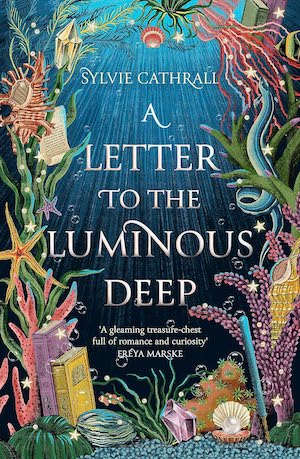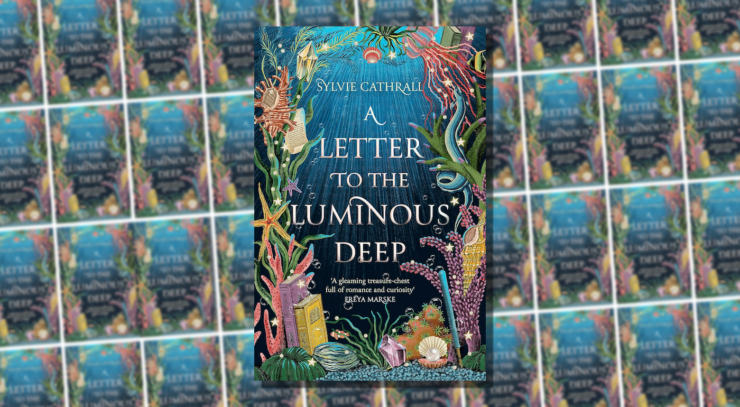Sylvie Cathrall’s debut novel, A Letter to the Luminous Deep, is a romantic book, and not just because of the burgeoning relationship unveiled between the two central characters. The story, told entirely in epistolary form, takes place over two timelines. The first centers on E. Cidnosin and the scholar, Henerey Clel. E. lives in an underwater abode called the Deep House, a home created by her now-deceased mother, who was a renowned architect. Unlike her two siblings, her scholar sister Sophy and her self-centered artistic brother Arvist, E. has not left the Deep House in years because of a “Malady of the Mind” that makes venturing outside of her home difficult. She is a reader of Henerey’s scholarly work, however, and sends him a letter about some unusual underwater creatures she observes outside the window one day. The two strike up a Victorian-esque correspondence that unfurls into love.
The second timeline centers on E. and Henerey’s siblings, Sophy and Vyerin, who strike up their own correspondence when E. and Henerey are presumed dead after a mysterious seaquake destroys the Deep House. The premise of their correspondence is to create an archive of their deceased siblings’ writings in order to commemorate them, and the two uncover—and partially solve—a mystery while doing so.
Both of these timelines occur on a planet almost completely devoid of land. The worldbuilding trickles out slowly, but we eventually find out that a thousand years ago, their vastly more advanced ancestors lived in “Islands in the Sky.” A cataclysmic event caused that civilization to crash on a world covered by water, leaving a handful of survivors to build anew. By definition, this makes A Letter to the Luminous Deep a post-apocalyptic story, but the book is far from the grim fare one expects from that subgenre. Life for Henerey, E., Sophy, and Vyerin is comfortable, with technology that roughly matches that of our early twentieth century. (Amenities like telephone communication, for example, have been newly implemented, as has a version of sending messages via telegraph or an antiquated form of email.)
Buy the Book


A Letter to the Luminous Deep
The writing style of this society, however, is solidly Victorian; if reading pages of prose that feel like letters written in a Jane Austen novel doesn’t sound appealing, this might not be the book for you. But if following a correspondence where two people who feel ostracized find solace and acceptance in each other and eventually move from bashful expressions of affection to eloquent statements of love sounds like an endearing, cozy read, then Luminous Deep will be right up your alley.
The intricate descriptions of this sea-dwelling society and of the slow growth of E. and Henerey’s relationship (and, to a lesser degree, Sophy and Vyerin’s relationship) are the strengths of the book; while the stakes at the core of the mystery around E. and Henerey’s disappearance appears to have massive implications, they happen almost in the background, with the burgeoning romance via correspondence the forefront of the story and our emotional anchor. The plot here, as little of a plot there is, is secondary.
Through all the letter writing, however, we learn about a mysterious “Structure” that has appeared outside of the Deep House, a creation that seems to be more than an art installation that Arvist claims he made. The truth of it slowly unravels, not least because violent geologic events happen near it with devastating consequences. We also travel to the deepest depths of the ocean with a team of scholars that includes Sophy and her future partner (a romance we also see unfold in the writings). Even living in the hadal depths sounds cozy in this book, despite the fact that their living quarters are subjected to enough pressure to pulverize a body into goo in seconds if any part of the structure failed.
A Letter to the Luminous Deep is about its characters, which Cathrall has crafted with exquisite detail. E., for example, suffers from severe anxiety and agoraphobia, and eloquently explains her condition to Henerey in one of her letters to him: “
“O Henerey, I can tell from your letters and from your academic writing that you have a wonderful imagination, so perhaps you understand how a lively mind can be as much of a burden as it is a gift. Mine tends to fixate on scenarios—memories—difficulties—and then embellish them with such detail that I feel as though calamities have actually happened, and I the cause of them.”
That passage not only gives you a sense of the book’s writing style, but also describes E.’s struggles with her condition. E.’s so-called “Maladay of the Mind,”’ however, doesn’t limit her or minimize her in any way, but is simply part of who she is, making her a rich, complex character that you can’t help but care about.
Character development aside, events move slowly—very slowly—over the novel’s 432 pages. The pace does pick up in the last fifth or so once we catch up to the present-day happenings impacting Sophy and Vyerin. But the nature of the epistolary format makes the story’s urgency muted, causing the book to strain under the confines of having the entire tale explained via letters and other collected writings.
And while the mystery around E. and Henerey’s disappearance is ultimately explained, it is far from resolved. Other questions about their civilization are not fully answered, though enough hints and clues are offered for a reader to piece together the nuts and bolts of what happened a thousand years and what happened to E. and Henerey. Those looking for a standalone novel won’t find it here—A Letter to the Luminous Deep ends suddenly, with the promise of a sequel that will presumably move the story forward. Whether that assumed sequel will also be in epistolary format—and whether that structure can deftly carry the story forward—remains to be seen.
A Letter to the Luminous Deep is published by Orbit.










